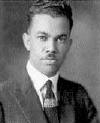Paul Revere Williams
| Paul Revere Williams | |
|---|---|
 |
|
| Born |
February 18, 1894 Los Angeles, California |
| Died | January 23, 1980 (aged 85) Los Angeles, California |
| Alma mater | University of Southern California |
| Occupation | Architect |
| Buildings | 1925 28th Street YMCA, Los Angeles 1935 Rene Faron Residence 1938 First Church of Christ, Scientist (Reno, Nevada) 1939 Saks Fifth Avenue, Beverly Hills 1940 Pueblo del Rio Housing Development (joint venture) 1948 Golden State Mutual Life Los Angeles 1949 and 1963 Perino's Restaurant (alterations of existing buildings) 1951 Williams Residence 1953 Imperial Courts Housing Development, Los Angeles 1958 Los Angeles Superior Court 1961 LAX Theme Building (joint venture) 1961 La Concha Motel 1962 St. Jude Hospital, Memphis 1963 First AME Church, Los Angeles 1964 Beverly Sunset Medical Center Los Angeles |
Paul Revere Williams, FAIA (February 18, 1894 – January 23, 1980) was an American architect based in Los Angeles, California. He practiced largely in Southern California and designed the homes of numerous celebrities, including Frank Sinatra, Lucille Ball and Desi Arnaz, Lon Chaney, Barbara Stanwyck and Charles Correll. He also designed many public and private buildings.
Orphaned at four years of age, Williams was the only African American student in his elementary school. He studied at the Los Angeles School of Art and Design and at the Los Angeles branch of the New York Beaux-Arts Institute of Design Atelier, subsequently working as a landscape architect. He went on to attend the University of Southern California, designing several residential buildings while still a student there. Williams became a certified architect in 1921, and the first certified African-American architect west of the Mississippi.
He married Della Mae Givens on June 27, 1917, at the First AME Church in Los Angeles. They had three children: Paul Revere Williams, Jr. (born and died June 30, 1925, buried in Evergreen Cemetery, Los Angeles); Marilyn Frances Williams (born December 25, 1926); and Norma Lucille Williams (born September 18, 1928).
Williams won an architectural competition at age 25, and three years later opened his own office. Known as an outstanding draftsman, he perfected the skill of rendering drawings "upside down." This skill was developed so that his white clients (who might have been uncomfortable sitting next to a black architect) could see the drawings rendered right side up across the table from him.
...
Wikipedia
